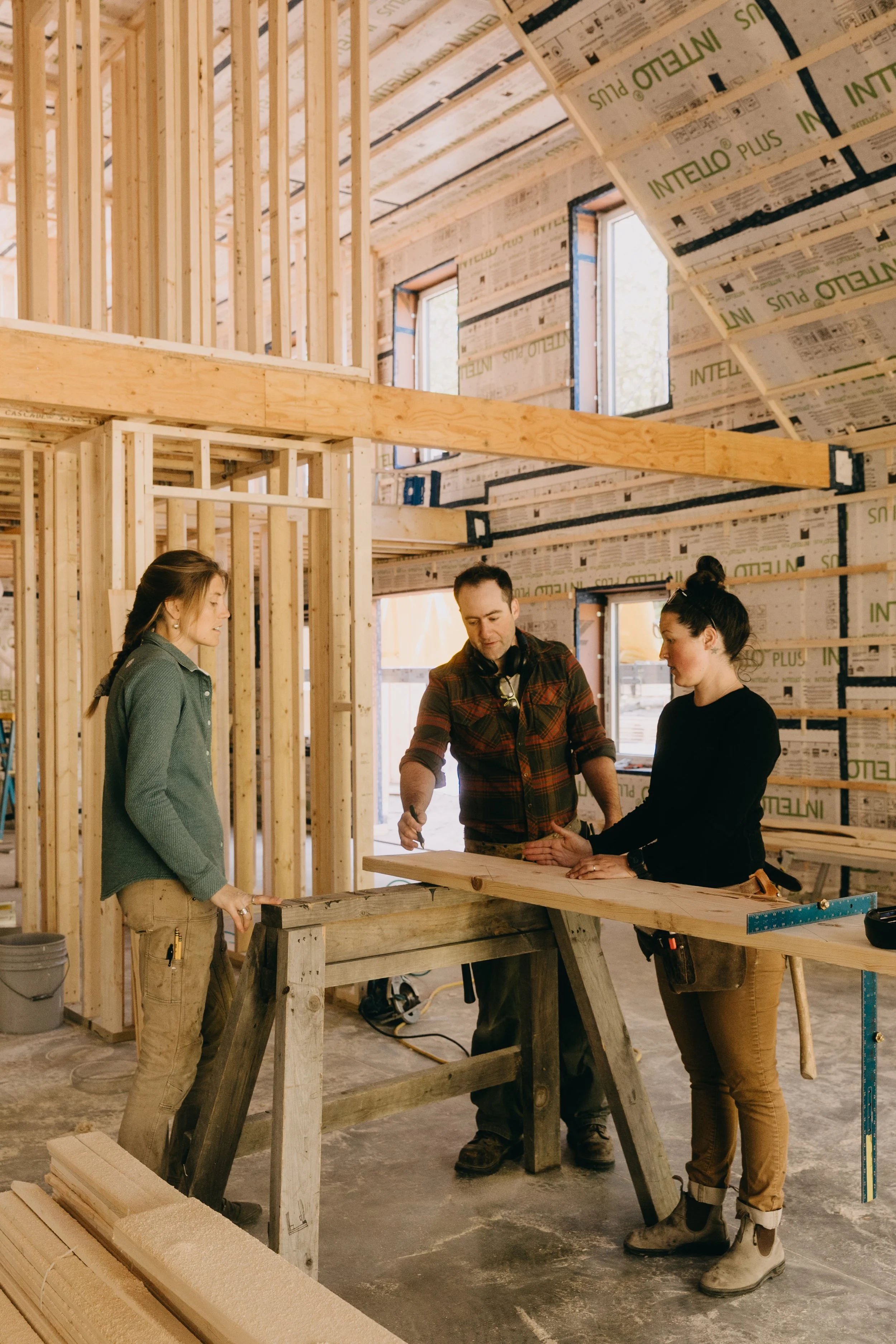Home team advantages
A project manager and carpenters review siding details. These discussions among the project team can help ensure quality control and ensure that the project goals are achieved.
By Anna Heath
Photos: Emily Delamater
The foundational step of building a home is building a project team. Here’s what that means and how to do it in a way that aligns with your goals and values.
“I want to build a house, but I don’t know where to start.”
“I have land and can put together a floor plan fairly easily because I know what I want.”
“I have an architect on retainer and a project timeline I desire.”
“I have a full set of plans and am looking for a builder.”
“I have a set of plans in development and want to hire a builder as we continue the design process.”
As a sales representative for a general contracting company in western Maine, these are common scenarios presented by prospective clients. In each of these cases, what is called for is a project team and a clearly defined set of goals and values.
A well-organized team can offer timely advice, expertise and connections that could help align your project more closely with your goals while saving significant time and money. A project team typically includes the owner or client, an architect, a project manager, builders, and vendors or suppliers; it may also involve engineers, community planners or municipal government.
A lead carpenter and project manager review siding material options. Builders might also be able to offer advice on material selections and treatments that can inform client decisions for cost savings in the budget.
If you’re the owner, take the time to determine your values so that you can make strategic hires. The success of a project depends on the active participation and the accountability of every member on the team as well as defining what “success” means.
At a minimum, owners typically want to:
Build a house that doesn’t fall down.
Build a house that doesn’t rot.
Stick to the budget.
Build a house that looks like the plans.
Pretty basic stuff. But don’t you want more than that? These questions can help you to clarify your values:
What is essential to make your house feel like a home? Is using local materials important to you? Are you interested in emphasizing sustainability during the construction of your home, or choosing a heating method that will reduce your environmental impact over time? Do you want a home that will last for generations?
When determining the goals of the project, how important is it to you that the home be completed by a certain time? When might you weigh aesthetics over other values? How important are health concerns, like air quality? What is your budget, and how closely does that need to be met? What may be “value-engineered” without sacrificing your vision or your sense of what is important?
who should be on your team
A project manager meets with carpenters to discuss stair and framing layouts. These discussions among the project team can help inform material orders with long lead times and ensure uninterrupted project schedules.
Knowing your values will help you identify the right people for your project team—professionals you can trust throughout the project. A typical project team includes the following members or roles:
Architect
Your project team should include someone who helps you visualize the house you want. This could be an architect with a degree and licensure; a designer/draftsperson who can create renderings and plan; or a design-build firm that combines the architect, project manager and builder roles. Alternatively, you can purchase a shared plan online that requires minimal revisions. Whichever way you go, it can be helpful to engage with a project manager or your builders early on to gather insights throughout the design process.
Project Manager / General Contractor
More often than not, the person who knows your project best is a project manager who helps you actualize the construction of your home. This could be a general contractor who coordinates the project schedule and manages scopes and contracts to create a seamless construction flow. Some homeowners choose to manage their own builds, contract work out to trades partners and handle permitting. This may work for you if you have a lot of time, but understand that construction project management has a learning curve. See more about this role on the next page.
Engineers
Many project teams, especially those for larger and highly customized homes, include one or more engineers. A mechanical engineer can help with heating, ventilation and air conditioning (HVAC) design. A civil engineer may be necessary when integrating a project into public works. A structural engineer will verify the integrity of the building and be legally responsible for the structural plans they sign off on. They have a vested interest in the durability and longevity of your home and want to ensure that every generation that passes through those halls is safe and sound. You may also need an environmental engineer to remediate the site before construction.
Builders & Trades partners
The builders work with their hands and bodies every day. They want to practice the craft that they have developed through hard work and daily learning. They work closely with trades partners, who may include excavators, concrete workers, insulators, plumbers, electricians, drywallers, HVAC specialists and painters. Some construction companies do a variety of these trades in-house. In my experience, trades partners and builders want to do the highest quality of work, not only so they don’t need to return later but so that their work endures. We take satisfaction in a job well done.
Consultants
Input from a consultant may be pivotal in design decisions, material selections and other build details. Consultants can help you determine energy performance, advise on building assembly details, provide aesthetic guidance, educate you on the lifetime of the building materials or certify building standards.
Vendors and suppliers
Vendors know what materials are available locally, understand the economic changes along the supply chain, and are motivated to find the best product for the best price. They develop close relationships with builders to ensure that the materials arrive when needed and are of high quality. Maine has many natural resources and suppliers offering local products with low embodied carbon and minimal transportation involved. In addition, using local lumber and other materials can direct your spending toward the local economy.
Communication on plan revisions is critical for project success. Architects and project managers must be timely and descriptive when communicating those changes to the builders.
Questions to ask your team
As you’re assembling your project team, here are some questions to ask:
How will you present information and project updates to me? And how often? ■ What is the mission of your company? How does that direct the work that you do?
How accurate are your estimates?
When I have a concern, what is the best way to discuss it with you?
In what ways will you ensure that my values are represented throughout the project?
How do you treat the other team members during a project? What do you do when things go wrong? What about when they go right?
What direction will you steer me in for material selections or for sourcing?
How do you approach the energy performance of your projects?
How do you ensure quality control and craftsmanship?
How do you guarantee the durability of your buildings?
How do you approach budget issues during the project?
What methods of accountability do we have and what agreements are we making within the contracts?
It is possible to manage the project yourself rather than working with a general contractor, but be prepared to put in a lot of time ensuring the project scope is clearly defined. You’ll have to oversee the work you are contracting and hold people accountable to quality, which can be difficult when they are the professionals in the field and you’re not. If you go this route, collect references and review completed projects before hiring trades partners. If you haven’t given your partners accurate information, reviewed their contracts and clearly defined your expectations, you might not get what you anticipated!
Create a contact sheet for all trades partners required and keep it up to date so you remember who you are waiting to hear back from and when you last contacted them. Remember, these trades partners have many other projects they are working on. Build a project schedule that accounts for permitting with local code enforcement officers and lead times for materials and other project delays.
Even if you engage a project manager, remember that as the client you’re still a critical member of the team. You set the tone by choosing professionals who align with your values and understand your vision. Ask for what you need, being realistic about what is achievable. Then try not to micro-manage (you probably don’t like people looking over your shoulder while you work, and neither do your builders).
Perhaps the most foundational aspect of setting out to build a home is creating a project team of qualified professionals who understand what you need and want. When developed early in the design process, this team can help you make informed decisions that will get more value for your dollar and better align the project with your values.
This article appeared in the Spring 2025 edition of Green & Healthy Maine HOMES. Subscribe today!
Find Maine experts that specialize in healthy, efficient homes in the Green Homes Business Directory.





